Our website is made possible by displaying online advertisements to our visitors.
Please consider supporting us by disabling your ad blocker.
Spin-1/2

| Part of a series of articles about |
| Quantum mechanics |
|---|
In quantum mechanics, spin is an intrinsic property of all elementary particles. All known fermions, the particles that constitute ordinary matter, have a spin of 1/2.[1][2][3] The spin number describes how many symmetrical facets a particle has in one full rotation; a spin of 1/2 means that the particle must be rotated by two full turns (through 720°) before it has the same configuration as when it started.
Particles having net spin 1/2 include the proton, neutron, electron, neutrino, and quarks. The dynamics of spin-1/2 objects cannot be accurately described using classical physics; they are among the simplest systems which require quantum mechanics to describe them. As such, the study of the behavior of spin-1/2 systems forms a central part of quantum mechanics.
- ^ Resnick, R.; Eisberg, R. (1985). Quantum Physics of Atoms, Molecules, Solids, Nuclei and Particles (2nd ed.). John Wiley & Sons. ISBN 978-0-471-87373-0.
- ^ Atkins, P. W. (1974). Quanta: A Handbook of Concepts. Oxford University Press. ISBN 0-19-855493-1.
- ^ Peleg, Y.; Pnini, R.; Zaarur, E.; Hecht, E. (2010). Quantum Mechanics (2nd ed.). McGraw Hill. ISBN 978-0-071-62358-2.
Previous Page Next Page



